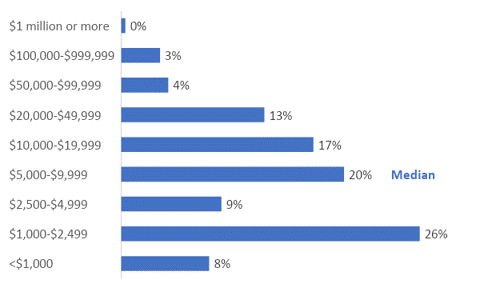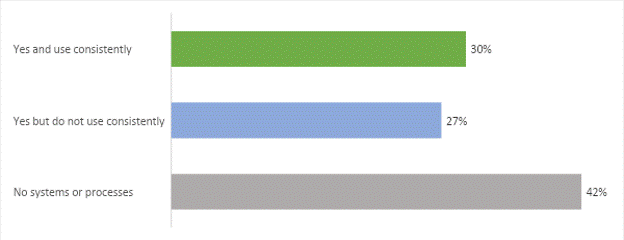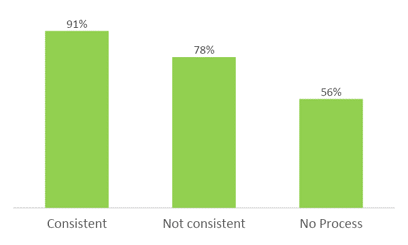 By Jeff Giannotto, Senior Solutions Advisor at MarketSmart
By Jeff Giannotto, Senior Solutions Advisor at MarketSmartAn argument can be made that research is the backbone of The Giving Institute. As the mission statement reads, The Institute exists “to actively champion thought leadership that empowers philanthropy.” What better way to do that than through research?
Opinions are great, but data is better, and with that in mind, it’s with great joy that today we’re able to share with you three key insights uncovered in this year’s Major Gift Benchmark Study. Similarly to the Giving Institute, our team at MarketSmart prides ourselves on furthering the sector through quality thought leadership, and what better way to do that than by sponsoring and empowering noteworthy researchers in our field.
This is the second Major Gift Benchmark Study, following one released in 2017. Click here to review the 2017 Major Gift Benchmark Study.
Designed by a group which included representatives from AFP, APC, DonorSearch, MarketSmart, and Melissa S. Brown & Associates, the study was created to acquire a “pulse” on the state of major gift fundraising. Thanks to 580 participating charities, we are able to further the conversation around what is and isn’t working in the realm of major gifts. And, even more interesting, we are able to compare results from the prior survey, conducted three years ago, to see what has and hasn’t changed.
Let’s dive in.
What is a major gift?
In our industry, it’s seemingly an age-old question, “What is a major gift?”
Every organization defines major gift differently. In this study, participants selected a range that includes the minimum value that qualifies as a major gift at their organization. Someone who selected the range of $1,000 to $2,499 might work at an organization where $1,000, or $1,500, or $2,000 is the minimum amount for a “major gift.”
The distribution shows study participants most often said that their organization defines a “major gift” when it falls in the range of $1,000 to $2,999 (the mode, or most frequent response, selected by 26 percent of study participants). The midpoint (median) falls in the $5,000 to $9,999 range. Half of the respondents selected that range or less and half selected that range or more.

Percentage of Responses to “What is the Lowest Amount that Qualifies as a Major Gift?”
Medians are the mid-point. Thus, some organizations that raise substantial sums of money still consider a gift less than $5,000 to be a “major gift.” In this study we found 20 percent of the organizations that raised $10 million or more annually defined “major gift” as something less than $5,000. This means that 20% of organizations that raise $10M or more annually consider a $5,000 or smaller gift to be a major gift. This indicates that even for large nonprofits, $5,000 serves as an interesting “threshold” for major gifts.
We found no change in the distribution of response to this question from the 2016 survey to the 2019 one.
Plans and processes
Unsurprisingly, we found that organizations that invest in major gift fundraising and include that investment as part of a strategic plan, regardless of organizational size, are more likely to achieve their major gift goals. This finding mirrors a similar result captured in the 2015 Individual Donor Benchmark Report.
To put it plainly, if an organization has a strategic plan that includes major gift fundraising goals, the organization is more likely to attain success in their efforts. However, just 43 percent of organizations met their major gift fundraising goals in 2019.
The study also investigated what types of processes (if any) organizations have in place to facilitate raising major gifts. Nearly 6 in 10 (58 percent) of organizations reported having systems or processes in place to identify major gift prospects. Traditionally, systems and processes to raise major gifts include a mixture of institutional knowledge, technology solutions, and dedicated staff members who cultivate and solicit major gifts. Of respondents:
- 30 percent use the systems/processes consistently.
- 28 percent have processes/systems but do not use them consistently.

Existence of Processes to Identify Major Gift Prospects (n=517)
Compared with 2016 these results differ, but because of the different sampling methods, we cannot say definitively about why other than a much higher percentage in 2019 said they have no processes for identifying major gift prospects.
| 2016 | 2019 | |
| Yes and used consistently | 37% | 30% |
| Yes but do not use consistently | 39% | 27% |
| No systems or processes | 24% | 42% |
The consistent use of processes to identify major gift prospects is associated with positive major gift fundraising outcome, including meeting major gift fundraising goals.
Figure 10: Met or Got Close to Major Gift Goals by Consistent, Not Consistent, or No Processes (n = 377)

Figure 10 excludes study participants with no major gift goal.
Of those with no processes for major gift prospect identification 61 percent solicited zero to ten major gifts.
Pipeline satisfaction is low
Nearly half (48 percent) of study participants said they would like new methods for identifying prospects when asked what would most benefit major gifts fundraising. This response is symptomatic of the never ending challenge development professionals face in building a pipeline of qualified major gift prospects to cultivate and engage with.
A variety of methods are used to identify potential major gift donors. Tactics range from using data and technology to simply asking a board member for a recommendation of who they know who might be a potential major gift donor. The Major Gift Benchmark Study explored each approach (tech-enabled and non tech-enabled) and the effect it had on meeting major gift fundraising goals.
The research magnified the need for organizations to strike a balance between tech-enabled and non tech-enabled donor discovery tactics. Relying on institutional knowledge alone is not enough to develop prospect profiles that are ideal for gift officers, and that is where tech-enabled solutions can help “fill the gap.”
Interestingly, 86 percent of respondents using five+ technology solutions met or got close to their major gift fundraising goals, compared to 49 percent using one or two and 25 percent using none. Tech-enabled donor discovery tools are able to help organizations succeed.
This sentiment can’t be consumed in a vacuum however, as overall pipeline satisfaction is still low, prompting the question of how technology can advance to further assist major gift pipeline development.
Get your free copy of the report
These are merely a few of the insights uncovered in the 2019 Major Gift Benchmark Report. If you would like a full copy, please click here. A great deal of thanks goes to Melissa Brown for conducting this research.
If you’re interested in reviewing the 2017 Major Gift Benchmark Study, please click here.


